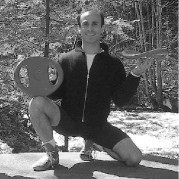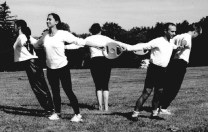Developing Smart Bells® took him more than 10 years. The former captain of Harvard's wrestling team, a 1984 U.S. Olympic-team alternate, had to rethink his training when he began suffering spinal compression injuries from lifting standard weights. As a biology concentrator he had investigated exercise physiology, and he had studied yoga and dance after college, so he developed a new exercise routine combining elements of dance, weightlifting (using a barbell disk), and Eastern concepts of fitness. By then he was coaching high-school wrestling in upstate New York. His students liked the routine, but not the heavy flat weight, so he sculpted a new shape by doing the movements with a clay prototype that he took to a local blacksmith to cast in metal. "The form naturally followed from the function," he says. He copyrighted his creation in 1994 as a sculpture because he wanted to "make an object so aesthetic and sensual that people would want to work out." He also patented both the sculpted weight and the circular exercise movements, writing his own patent application with the aid of a do-it-yourself book.
 |
| Paul Widerman shows off two Smart Bells® His "functional sculpture" can be used to work out alone or with others; group exercises like the "inverted circle" below, he says, build teamwork as well as fitness. |
 |
| Courtesy of ThinkFit |
He discovered that senior citizens, women, and children were his first serious customers. "They didn't have to unlearn that 'No pain, no gain' philosophy," he says, "and they were more open to new things"like a fitness trainer who refers to his core routines as piano scales and advises users to finish their exercise sessions by putting on some music they like and improvising their own movements with the Bell.
Widerman estimates that there are about 5,000 Bells in the world by now. The school district where he coached wrestling bought 50. The Yankees, the Mets, and the Knicks have bought some; so have the U.S. Navy SEALS. He has taught his routines at Stanford Business School's executive program for nonprofit leaders and at a Fitness Forum in New York City sponsored by Pfizer and the Women's Sports Foundation as part of a depression-awareness campaign. Thinkfit® still consists only of Widerman, a manager to run the office and Thinkfit.com, and various artists and trainers who help out as needed, but, he says forthrightly, "I have slipped out of my reclusive artistic period and am heavily into promotion!"
Even so, he has not forgotten the larger picture. Recently he spoke with a Harvard wrestling teammate, Neil Tyson '80, who talked with him in college about the "need to follow your passion." Astrophysicist Tyson, director of the Hayden Planetarium, confirmed that the Bell's saddle form is one of three possible shapes of the universe as predicted by the theory of relativity. Widerman had already noticed that the Bell's biaxial curve casts the shadow of a Möbius band, and that all the movements he's developed are orbital. "This is turning into something way more significant than I ever imagined," he says. "I'm either going crazy or I'm on to something."
~Jean Martin





